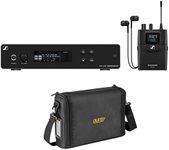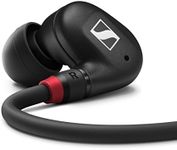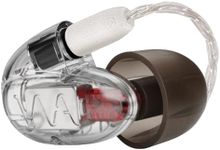Buying Guide for the Best In Ear Monitor Systems
Choosing the right in-ear monitor (IEM) system is all about matching your needs as a performer, musician, or presenter with the features that will give you the best sound, comfort, and reliability. In-ear monitors help you hear yourself and others clearly on stage or during performances, reducing stage noise and protecting your hearing. To find the best fit, you should understand the main specifications and how they relate to your intended use, whether it's for live music, rehearsals, or presentations.Wireless Frequency RangeThe wireless frequency range refers to the set of radio frequencies the system uses to transmit audio from the transmitter to the receiver (your bodypack). This is important because certain frequencies may be crowded or restricted in your area, which can cause interference or legal issues. Frequency ranges are often divided into bands (like UHF or VHF), with UHF generally offering better performance and less interference. When choosing, check which frequencies are legal and least crowded in your region, and pick a system that allows you to select or switch channels if needed.
Number of ChannelsThe number of channels indicates how many separate mixes or users can operate simultaneously without interference. This matters if you have multiple performers needing their own monitor mixes. Systems with more channels are better for bands or groups, while solo performers may only need one. Consider how many people will use the system at once and choose a system that supports at least that many channels.
Audio Quality (Frequency Response and Signal-to-Noise Ratio)Audio quality is determined by specs like frequency response (the range of sounds the system can reproduce) and signal-to-noise ratio (how much background noise is present). A wider frequency response means clearer, more natural sound, while a higher signal-to-noise ratio means less unwanted noise. For critical listening or professional use, look for systems with a broad frequency response (for example, 20 Hz to 20 kHz) and a high signal-to-noise ratio (above 90 dB). If you just need basic monitoring, these specs can be less demanding.
Transmitter and Receiver Build QualityBuild quality refers to how sturdy and reliable the transmitter (sends the audio) and receiver (worn by the user) are. This is important because these devices are often used in active environments and need to withstand drops, sweat, and frequent handling. Systems with metal housings or reinforced plastics are more durable. If you perform often or travel, prioritize robust build quality; for occasional or stationary use, lighter builds may suffice.
Battery Life and Power OptionsBattery life tells you how long the receiver will last on a single charge or set of batteries. This is crucial for long performances or rehearsals. Some systems use rechargeable batteries, while others use standard AA or AAA batteries. Longer battery life means less worry about losing sound mid-performance. If you have long gigs or rehearsals, look for systems with extended battery life or easy battery swaps; for short sessions, this is less critical.
Fit and Comfort of EarbudsThe fit and comfort of the included earbuds (or the compatibility with your own) affect how long you can wear the system without discomfort and how well you can block out external noise. Some systems come with universal-fit earbuds, while others allow for custom-molded options. If you plan to wear them for hours, prioritize comfort and a secure fit; if you already have preferred earbuds, check compatibility.
Range and Signal StabilityRange is the maximum distance you can move from the transmitter before the signal drops out. Signal stability refers to how consistently the system maintains a clear connection without dropouts or interference. If you move around a large stage or venue, choose a system with a longer range and proven stability; for small spaces or stationary use, a shorter range may be sufficient.


















